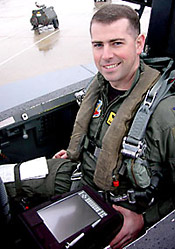WASHINGTON -- The U.S. Air Force has taken tablet PCs
higher than Bill Gates ever imagined and so far has not encountered the
"blue screens" cursed by ground-bound Windows users.
The Air Force quickly adapted a commercial tablet PC to provide
critical targeting and navigation information to aircrews operating over
Afghanistan in Operation Enduring Freedom, fielding pen-input systems to
combat aircrews in just three months. It's a turnaround tough in the
corporate world and almost unheard of in the government where acquisition
and deployment cycles are measured in years. The system also can go a long
way toward preventing the kind of "friendly fire" incidents that resulted
in casualties in Operation Desert Storm and early in the Afghanistan
campaign.
The Windows 2000-based tablet PC system has experienced "no blue
screens" despite rigorous in-flight testing that put it through better
than 3G aerial maneuvers, according to Robert Severino, president of
Position Integrity LLC, a Los Gatos, Calif.-based company that developed
the Pilot/Aircrew Management (PACMAN) system.
The Air Expeditionary Battelab, located at Mountain Home Air Force
Base, near Boise, Idaho, turned the PACMAN from an 18-month development
project into a fielded, though still prototype, combat system, according
to Severino, who showcased PACMAN in the Air Force booth at the annual
Armed Forces Communications-Electronics Association conference here.
 |
 |
| A U.S. Air
Force weapon systems officer displays the tablet PC used aboard an
F-15 strike fighter. |
 |
Capt. Erik Jordan, director of
communications programs at the Battelab, said the quick deployment of
PACMAN illustrated the Battelab's mission to "leverage commercial
technology and get it in the hands of users as quickly as possible,
avoiding the sometime long delays," of the standard military acquisition
cycle. Severino said Position Integrity received the PACMAN contract last
December and under rush order delivered 20 prototype units to an F-15
squadron at Seymour Johnson Air Force Base in March. That squadron is now
supporting the Afghanistan campaign.
Severino said PACMAN is designed to provide digital information to
crews of Air Force aircraft that lack such systems, including the F-15,
the A-10 attack aircraft as well as Army AH64, UH60 and CH47 helicopters.
Position Integrity built PACMAN to run on a tablet PC from Fujitsu Ltd. in
Tokyo and to be worn by a crewman as a kneepad computer. This, Severino
said, makes ergonomic sense, since the computer replaces paper navigation
charts printed in notebook form and attached to a pilot's knee.
Position Integrity used Java applets to develop software buttons that
make it easy for pilots to screen through various applications and then
pages within each applications, eliminating one screen. Target imagery,
which is obtained from satellites or photo reconnaissance aircraft, is a
key PACMAN application, Severino said, since older aircraft, including the
F-15, don't have built-in digital target imagery systems. Precision
bombing, based on smart weapons using high-resolution target imagery and
Global Positioning System (GPS)-derived coordinates, has been a hallmark
of the U.S. air campaign in Afghanistan.
PACMAN ties into a commercial GPS receiver -- the kind a hiker or a
private pilot could buy for several hundred dollars --and that provides
the aircrew with precise position information fed into a moving map
display stored on the PACMAN. Digital maps are provided by the National
Imagery and Mapping Agency, Severino said. The pilot uses Velcro to stick
the GPS receiver next to a cockpit window and plugs a cable into the
tablet PC.
Pilots can also use PACMAN to access weather information, preloaded
before each flight for their operational area. If they encounter
mechanical or system problems, they can quickly jump to a digital tech
manual for troubleshooting advice.
Position Logistics is also developing a version of PACMAN to be used by
Tactical Aircraft Control Party controllers, who operate on the ground
with infantry or Special Forces units to help them coordinate airstrikes.
Severino said the Air Force intends to use a secure data link over a
satellite system operated by Iridium Satellite LLC to exchange precise,
GPS-derived digital map-based targeting information. Severino said this
would help reduce casualties caused by misdirected ordnance. Severino said
24% of the 35 U.S. casualties in Operation Desert Storm during the Persian
Gulf War in Kuwait and Iraq were caused by badly aimed friendly fire from
U.S. aircraft. Early in the Afghanistan air campaign, ordnance misdirected
by ground controllers exploded near a Special Forces team, resulting in
the death of three U.S. Green Berets and 25 Afghan allies and wounding
Afghan Prime Minister Harmid Karzai.
Source: Computerworld